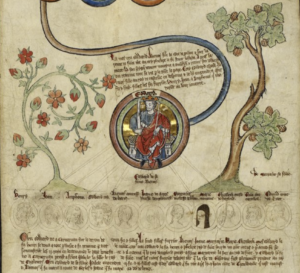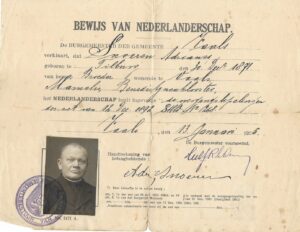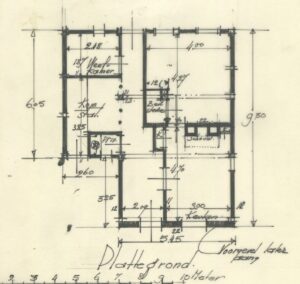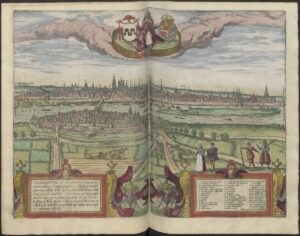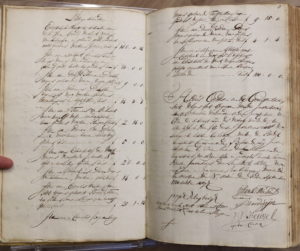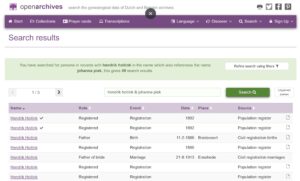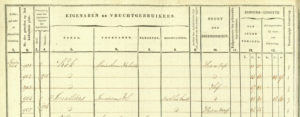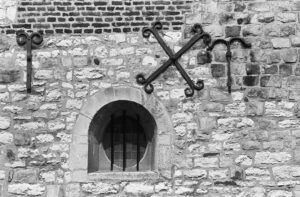If you're lucky, your literature research may reveal a book published about your family done by genealogists in the past. Writing such books was popular in the nineteenth century, especially for prominent families, or descendants of early settlers of a colony, for example. Several such books exist for New Netherland settlers. In many of these early books, chapter 1 is where the author tries to sketch the early history of the family. This is where you find claims of royal descent, of … [Read more...]
Dutch term – Afstamming
Afstamming means descent. For example, I am trying to prove my afstamming from Eleanor of Aquitaine. The word afstamming is used for biological or legal descent. Like in English, the type of descent is often not made explicit. … [Read more...]
Dutch Genealogy News for June 2021
This is an overview of new sources, projects, and other news that was announced last month. Sources Village records from Berkel, Enschot and Heukelom (1579-1813), Hilvarenbeek (1392-1810) and Oisterwijk (1390-1814) have been digitized. Scans can be found in the finding aids at the Regionaal Archief Tilburg website (links in blogpost). Cadastral records from Limburg since 1842 are available via Aezel. Scans of manumission records from Curacao are now available via the finding aid of … [Read more...]
Dutch term – Plattegrond
A plattegrond is a plan or map. You can often find plattegronden of a house or larger areas in image collections of archives or the Rijksdienst voor het Cultureel Erfgoed (Culturel Heritage Service). I am currently doing a House History module at the university of Dundee, for which I am studying the history of a house in Bredevoort. As part of the research I found a plattegrond of the house in the collection of the Rijksdienst voor het Cultureel Erfgoed. This plan showed the situation in … [Read more...]
Best Websites for Old Maps of the Netherlands
I love old maps. They give a snapshot of what the area looked like where my ancestor lived and are great illustrations for publications about my ancestors. Here are some of my favorite places to find old maps. City Atlas of Braun and Hogenberg, 1572 The City Atlas of Braun and Hogenberg covers cities in all of Europe. The 1572 atlas is available via the Utrecht University Library website. Blaeu atlas 1649 The Blaeu atlas from 1649 has maps of each region in the … [Read more...]
Dutch term – Boedelhouder
A boedelhouder literally is an estate keeper; the person who keeps possession of the estate of a deceased person until the estate is settled and divided. If the deceased was married, the boedelhouder would typically be the surviving spouse. … [Read more...]
Quick tip – Use & in Open Archives
If you are using Open Archives for your research, try searching for two persons at once by using the & operator. Example: Hendrik Hoitink and Johanna Piek Let's say I am looking for my ancestors Hendrik Hoitink and Johanna Piek. Searching for Hendrik Hoitink gives me 404 results. Searching for Johanna Piek gives me 1,456 results. That's a lot of results to wade through! Most of them will be irrelevant. However, if I search for Hendrik Hoitink & Johanna Piek, I get just 49 … [Read more...]
Dutch term – Oorspronkelijke Aanwijzende Tafel
An Oorspronkelijke Aanwijzende Tafel or Original Indicator Table is a ledger of the cadastral administration. It was created in 1832 to show the owners of the plots at that time, when the cadastral administration was introduced. It is organized by municipality and section, and lists all the property owners in that section, or order of plot number. It is commonly abbrevated as OAT. See Cadastre - Original Indicator Table for more information about this source and how to use it. … [Read more...]
Instructor at SLIG Advanced Evidence Analysis Practicum!
I am excited to announce that I will be one of the instructors for the Advance Evidence Analysis Practicum at the Salt Lake Institute of Genealogy this Fall! The practicum is a six-week virtual course, where every week, a new instructor will introduce a case. Students will then work by themselves to solve it, and at the end of the week, they will discuss the outcome. The instructor will then show how they solved the case. This allows students to compare strategies to see what worked and what … [Read more...]
Dutch term – Muuranker
A muuranker [literally: wall anchor] is a wall tie, a piece of iron that is used to secure the outer wall to the timber frame of a building. If you are visiting a town where your ancestors lived, either in person or on Google Streetview, and see wall ties, you know it's an older house (say, before 1850). Some houses with wall anchors have timber frames that go back to the medieval period, when the frames would be filled with wattle and daub but have since been replaced with … [Read more...]

